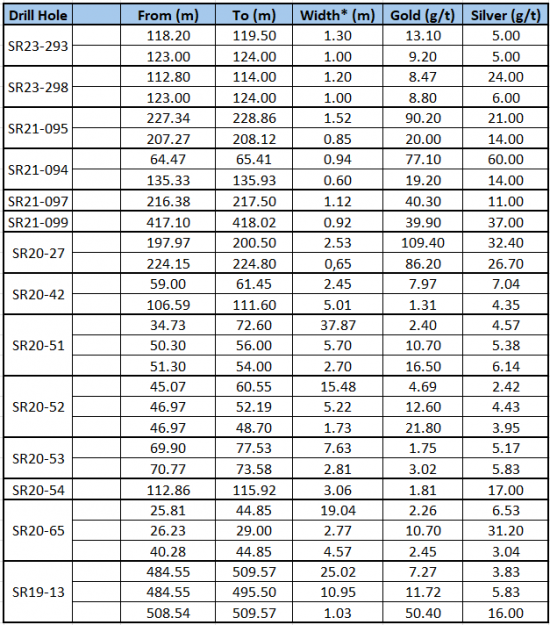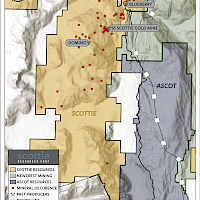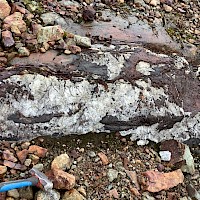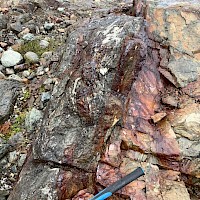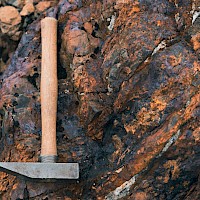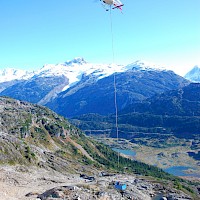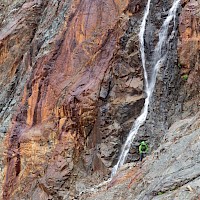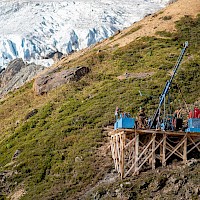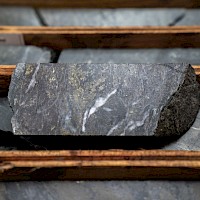The Scottie Gold Mine zone is located 32 km north of Stewart, BC, and is situated 20 km north of Ascot’s Premier Gold Mine and 27 km south of Newcrest’s Brucejack Mine. Scottie Gold Mine is a past producing mine that operated from 1981 to 1985, and produced 95,426 oz gold at an average grade of 16.2 g/t. The Scottie Gold Mine zone is covered by 14 Crown granted claims which are contiguous with 2 modified grid system claims. Scottie Resources has 100% interest in the Scottie Gold Mine subject to a 3% NSR (of which 2% can be purchased for $600,000). The mineralized veins of the Scottie Gold Mine are hosted within the Early Jurassic Unuk River andesite unit of the Hazelton Group and appear to be derived from a similarly-aged intrusion of the Texas Plutonic suite. This setting is similar to several other precious and base metal deposits in the area, including Snip, Premier-Dilworth, Red Mountain, Brucejack, Kerr-Sulphurets-Mitchell, Snowfield and Bronson Slope.
Drilling in 2019 by Scottie Resources confirmed that the Scottie Gold Mine was neither mined out nor drilled off. Results from drill hole SR19-13 include 7.27 g/t gold and 3.83 g/t silver over 25.02 m, which includes 11.72 g/t gold and 5.83 g/t silver over 10.95 m.
During the 2020 season, 2,815 metres of drilling and extensive surficial rock sampling was completed at the Scottie Gold Mine. Results have produced high-grade gold, such as an intercept of 109.4 g/t gold over 2.53 m (October 6, 2020).
In 2021, 4,462 metres of drilling and rock sampling took place at the Scottie Gold Mine, resulting in more high-grade gold discoveries, including 37.2 g/t gold over 3.71 m (January 14, 2022) and 9.0 g/t gold over 7.39 m (February 22, 2022). In addition to drilling, detailed geological mapping was completed over the mine area to gain a further understanding of the structural nature of the deposit. Several mineralized vein systems that were not mapped in previous campaigns, partially due to glacial coverage, were identified and remain to be drill-tested.
In 2022, a significant expansion of the Scottie Gold Mine was undertaken with additional drilling. This strategic drilling was aimed at the exploration of new high-grade gold prospects. The operation was executed with precision, contributing to a more comprehensive understanding of the mine’s geological structure. Concurrently, an HLEM survey was completed over the area, furthering our knowledge, and aiding in the identification of new potential targets. Notably, the historic 3% royalty on the mine was also acquired in 2022, providing us with greater operational control. This acquisition and the subsequent exploration activities have broadened the scope for future exploration.
In 2023, drilling at the Scottie Gold Mine consisted of two holes for a total of 407.4 m. The main objective of drilling at the Scottie Gold Mine was to expand the mineralized extent of the P Zone along strike and at depth. Both holes intercepted Au-bearing sulphide mineralization and moderate sericite-chlorite alteration. Notable assay results include 6.89 g/t Au and 4.2 g/t Ag over 5.8 m from SR23-293, 7.9 g/t Au and 2 g/t Ag over 2 m, 7.11 g/t Au and 25.4 g/t Ag over 1.65 m and 2.17 g/t and 3 g/t Ag over 8.85 m from SR23-298.
Table1: Select Drill Intercepts from 2019-2023. *True width is estimated to be 80-90% of interval width.
Project Highlights:
- Past gold producer with an active mine permit
- The property is road accessible from the Granduc Road, and is 1 km west from the Brucejack Transmission Line
- Existing underground 200 tonne/day mill
- Underground infrastructure includes: 6 portals, shafts, rail system, and 7 km of drifts
- The deposit remains open along strike and at depth, and has potential for multiple parallel mineralized structures
- Limited exploration drilling on the property - at surface, numerous high-grade mineralized veins have been identified but never drilled
- Excellent potential to significantly expand resources and reserves
A three-dimensional model of the historic Scottie Gold Mine deposit
The Scottie Gold Mine shut down on February 18, 1985 due to a high interest rate on the $20M loan required to start the mine and a drop in gold price from approximately $600 to $320. At the time of shutdown, mill recoveries were at 92-95% and reserves in all categories were estimated at 132,306 short tons grading 0.56 oz Au /short ton (17.50 g/t Au). Since its closure, limited work has been completed on the Scottie Gold deposit with known ore zones open in multiple directions. The Scottie Gold Mine historical estimate does not comply with CIM Definition Standards on Mineral Resources and Mineral Reserves as required by NI 43-101 and has no comparable resource classification. A qualified person has not done sufficient work to classify the historical estimate as a current mineral resource and Scottie is not treating this historical resource as a current resource.
The deposit consists of a number of east-west to northwest trending, steeply dipping, shear veins. At least 13 zones of gold-bearing quartz-carbonate sulphide (pyrite ± arsenopyrite ± pyrrhotite ± chalcopyrite ± galena ± sphalerite) veining occur on the property. These veins host sulphide-rich shoots with highly anomalous gold values and are hosted in a package of andesitic volcanics from the Unuk River Formation that are situated adjacent to the contact with the Summit Lake stock, part of the early Jurassic aged Texas Creek Plutonic Suite. The style of mineralization is characteristic of intrusion-related mesothermal veins.


